We strive to cultivate a new generation of professionals equipped with the skills and knowledge needed to address challenges in the cattle industry. This involves providing comprehensive education and training to graduate students, enabling them to generate, discern, and effectively communicate solutions for various aspects of science and cattle production.
The University of Nebraska-Lincoln has long been recognized for its exceptional graduate training in ruminant nutrition, boasting a legacy of producing students equipped with a deep understanding of cattle nutrition and its practical applications in the industry. Equipped with robust critical thinking skills and industry acumen, our graduates are adept at making informed decisions, seamlessly integrating into successful careers within the field and significantly propelling its progress.
Program Features
Industry Engagement
Students gain direct experience through on-farm visits, interacting with producers and extension professionals. They actively participate in educational events designed for cattle producers, ensuring they understand and address real-world issues.
Comprehensive Research Experience
Our beef-focused students work as part of a collaborative research team, tackling challenges across the entire cattle production cycle—from birth to slaughter. This hands-on research helps develop strategies that support both industry success and sustainability
High-Capacity Research Facilities
Our program provides access to extensive research facilities across Nebraska. These high-capacity facilities are instrumental in conducting applied research aimed at solving real-world problems in areas such as grazing systems, feedlot management, and integrated crop-livestock systems, preparing students to address the evolving needs of the cattle industry.
Notable Courses
Feedlot Nutrition and Management (ASCI 820)
Nutritional requirements of and complete ration formulation for feedlot cattle. Management practices needed for successful feedlot operation.
Advanced Animal Nutrition (ASCI 821)
Advanced course dealing with the nutrition of domestic animals. In-depth coverage of nutrients, nutrient metabolism, and nutrient requirements. Biochemical and physiological functions of nutrients in life processes.
Advanced Feeding and Feed Formulation (ASCI 822)
Feeding practices for domestic animals. Applied animal nutrition and feed formulation.
Forage Quality (ASCI 824)
The chemical characteristics of forage components. The interactions with ruminant physiology and digestion that influence forage feeding value. The laboratory procedures used to evaluate forages for grazing livestock.
Forage Evaluation (ASCI 924)
Offered even-numbered calendar years. Analytic procedures and research methods used in evaluating biochemical components and nutritive value of forages. An evaluation of the impact of forage quality on forage breeding and animal performance.
Biochemistry of Nutrition (ASCI 949)
Offered odd-numbered calendar years. Interrelationships of nutrients, nutritional state and metabolic processes. Energy metabolism, integration of nutrition and metabolism and nutritional regulation of gene function.
Other Graduate Courses
These are just some of the courses you will take in our graduate program. Click below to learn more about our other animal science graduate courses.
Explore CoursesAnimal Science Graduate Programs
- Typically completed in 2 years
- 30 credit hours required
(including 6-10 research thesis hours)
- Typically completed in 4-5 years after the B.S. degree or 2-3 years beyond the M.S. degree.
- One half (90 credit hours beyond the B.S. degree) must be completed at the University of Nebraska-Lincoln.
- A professional degree in agricultural science, community development and natural resources at the master’s level
- Flexibility that allows you to design an area of study that addresses your educational goals
- Online courses allowing you to earn the degree remotely
- Animal Science
- Beef Cattle Nutrition
- Extension Education Experience
- Teaching Engagement Experience
Huskers Do Big Things
Our Research
Our ruminant nutrition research is centered on addressing the real-world challenges faced by the cattle industry. We are committed to advancing knowledge in efficient, profitable, and sustainable cattle production, conducting innovative research that has a significant impact in Nebraska and beyond.
Explore ResearchOur Faculty
Prior to applying, please contact a specific animal science faculty member in your area of interest. Click below to meet some of our faculty in this specialization.
Meet the Specialization FacultyQuestions? We're Here to Help
If you have questions about any of our specializations within the Animal Science graduate program, please contact a member of our graduate student services team below.


